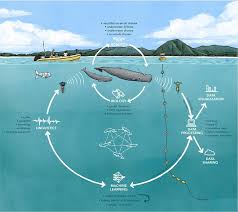Revolutionizing Whale Communication: How Drones Are Learning to Find Sperm Whales

Imagine a world where we can finally decode the mysterious conversations of sperm whales, the gentle giants of the ocean. Project CETI (Cetacean Translation Initiative) is on a mission to make that a reality by collecting millions, if not billions, of high-quality vocalizations from these magnificent creatures. But here’s the catch: tracking sperm whales is no easy feat. Knowing where they will surface is like trying to predict the weather; it requires a lot of guesswork and precision.
Today, a research team led by Stephanie Gil, an Assistant Professor of Computer Science at Harvard's John A. Paulson School of Engineering and Applied Sciences (SEAS), has introduced an innovative solution. They proposed a groundbreaking reinforcement learning framework that employs autonomous drones to locate and predict the surface behavior of sperm whales. This exciting research has just been published in *Science Robotics*.
The team is utilizing advanced sensing technology, specifically aerial drones equipped with very high frequency (VHF) signal sensing capabilities. These drones can analyze signals from the tags attached to the whales, functioning like an 'antenna array in the air.' This technology allows them to estimate the direction from which the whales' vocalizations are coming, giving researchers valuable insights into their communication patterns. By combining sensor data with predictive models of sperm whale dive behavior, they can forecast when and where a whale is likely to surface. This knowledge is crucial for optimizing the drone's route to maximize encounters with these oceanic mammals.
Not only does this research enhance our understanding of sperm whales, but it also has potential conservation applications. By knowing where whales are likely to surface, we can develop strategies to help ships avoid collisions with these majestic animals. The study introduces the Autonomous Vehicles for whAle Tracking And Rendezvous by remote Sensing (AVATARS) framework, which harmonizes two essential components: autonomy, which dictates the drone's movements, and sensing, which measures the Angle-of-Arrival (AOA) from whale tags to guide decision-making.
The AVATARS framework takes measurements from the drones and existing underwater sensors to inform its autonomous decision-making algorithm, striving to minimize missed opportunities to rendezvous with whales. This innovative approach parallels rideshare apps, which use real-time data to efficiently match drivers with passengers. Similarly, Project CETI tracks whales in real-time, aiming to coordinate the drone's rendezvous with the whale as it surfaces.
As the research unfolds, it brings Project CETI closer to its ambitious goal of collecting vast amounts of whale vocalizations. With a diverse array of data at their disposal, the team can refine their location estimates and routing algorithms, paving the way for more efficient data collection.
“I’m thrilled to contribute to this breakthrough for Project CETI. By leveraging autonomous systems and advanced sensor integration, we’re tackling key challenges in tracking and studying whales in their natural habitats,” said Gil. “This is not just a technological leap; it’s a vital step toward understanding the intricate communications and behaviors of these magnificent creatures.”
David Gruber, the Founder and Lead of Project CETI, expressed similar enthusiasm: “This research marks a significant milestone for our mission. We can now significantly enhance our capacity to gather high-quality datasets on whale vocalizations and their behavioral context, bringing us closer to interpreting what sperm whales are really saying.”
Ninad Jadhav, a PhD candidate at Harvard and the paper’s first author, noted, “This project was an incredible opportunity to test our systems in a challenging marine environment. Our interdisciplinary approach combines wireless sensing, artificial intelligence, and marine biology, showcasing how robotics can help us unravel the social behaviors of sperm whales.”
Sushmita Bhattacharya, a postdoctoral researcher in Gil's REACT Lab at SEAS, added, “This project is a fantastic chance to apply our algorithms in the field, where robotics and artificial intelligence can enhance data collection and accelerate research in language processing and marine biology, ultimately contributing to the preservation of sperm whales and their habitats.”
For more information on Project CETI and its groundbreaking work, you can visit [Project CETI](https://www.projectceti.org/).
Story Source:
Materials provided by Harvard John A. Paulson School of Engineering and Applied Sciences. The original text of this story is licensed under a Creative Commons License. Note: Content may be edited for style and length.
Journal Reference:
- Ninad Jadhav, Sushmita Bhattacharya, Daniel Vogt, Yaniv Aluma, Pernille Tonessen, Akarsh Prabhakara, Swarun Kumar, Shane Gero, Robert J. Wood, Stephanie Gil. Reinforcement learning–based framework for whale rendezvous via autonomous sensing robots. Science Robotics, 2024; 9 (95) DOI: 10.1126/scirobotics.adn7299

0 Comments